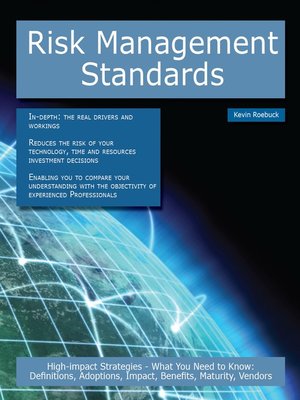Risk Management Standards: High-impact Strategies - What You Need to Know: Definitions, Adoptions, Impact, Benefits, Maturity, Vendors
ebook
By Kevin Roebuck

Sign up to save your library
With an OverDrive account, you can save your favorite libraries for at-a-glance information about availability. Find out more about OverDrive accounts.
Find this title in Libby, the library reading app by OverDrive.



Search for a digital library with this title
Title found at these libraries:
| Library Name | Distance |
|---|---|
| Loading... |
Risk management is the identification, assessment, and prioritization of risks (defined in ISO 31000 as the effect of uncertainty on objectives, whether positive or negative) followed by coordinated and economical application of resources to minimize, monitor, and control the probability and/or impact of unfortunate events or to maximize the realization of opportunities. Risks can come from uncertainty in financial markets, project failures (at any phase in development, production, or sustainment life-cycles), legal liabilities, credit risk, accidents, natural causes and disasters as well as deliberate attack from an adversary or events of uncertain root-cause. Several risk management standards have been developed including the Project Management Institute, the National Institute of Science and Technology, actuarial societies, and ISO standards. Methods, definitions and goals vary widely according to whether the risk management method is in the context of project management, security, engineering, industrial processes, financial portfolios, actuarial assessments, or public health and safety.
The strategies to manage risk include transferring the risk to another party, avoiding the risk, reducing the negative effect or probability of the risk, or even accepting some or all of the consequences of a particular risk.
Certain aspects of many of the risk management standards have come under criticism for having no measurable improvement on risk, whether the confidence in estimates and decisions seem to increase.
This book is your ultimate resource for Risk Management Standards. Here you will find the most up-to-date information, analysis, background and everything you need to know.
In easy to read chapters, with extensive references and links to get you to know all there is to know about Risk Management Standards right away, covering: Risk management, Association of Management Consulting Firms, Peter L. Bernstein, Black swan management, Building Safer Communities. Risk Governance, Spatial Planning and Responses to Natural Hazards, Burn pit, Cascading Discontinuity Sets, Dangerous Goods Safety Advisor, Defensive driving, David Eager, Exposure Factor, Michael Featherstone, Financial risk management, Fish & Richardson, Flood Forecasting Centre, Hazard prevention, Institute of Risk Management, Investment Controlling, ISO 31000, List of books about risk, Master of Science in Risk Management Program for Executives, Megaprojects and Risk: An Anatomy of Ambition, Moody's Analytics, Occupational safety and health, Opasnet, Open assessment, Operational risk management, Profit risk, Project risk management, Ready Georgia, Risk assessment, Risk governance, Risk International, Risk management framework, Risk management tools, Risk pool, RiskAoA, Security risk, Singapore Mercantile Exchange, Singapore Workplace Safety and Health Conference, Student Investment Advisory Service (SIAS Fund), Tactical Risk Management, Julian Talbot (risk management), Tsunami, Tsunamis in lakes, Risk, 100-year flood, Absolute probability judgement, Cultural Theory of risk, Decision theory, Digital Repository Audit Method Based on Risk Assessment, Disappointment, Disneyland model, Bill Durodié, Economics of security, Emergency, Fixes that fail, Flood risk assessment, Functional Safety, Global Earthquake Model, GRCM, Hazard, Health effects of sun exposure, High reliability organization...and much more.
This book explains in-depth the real drivers and workings of Risk Management Standards. It reduces the risk of your technology, time and resources investment decisions by enabling you to compare your understanding of Risk Management Standards with the objectivity of experienced professionals.






